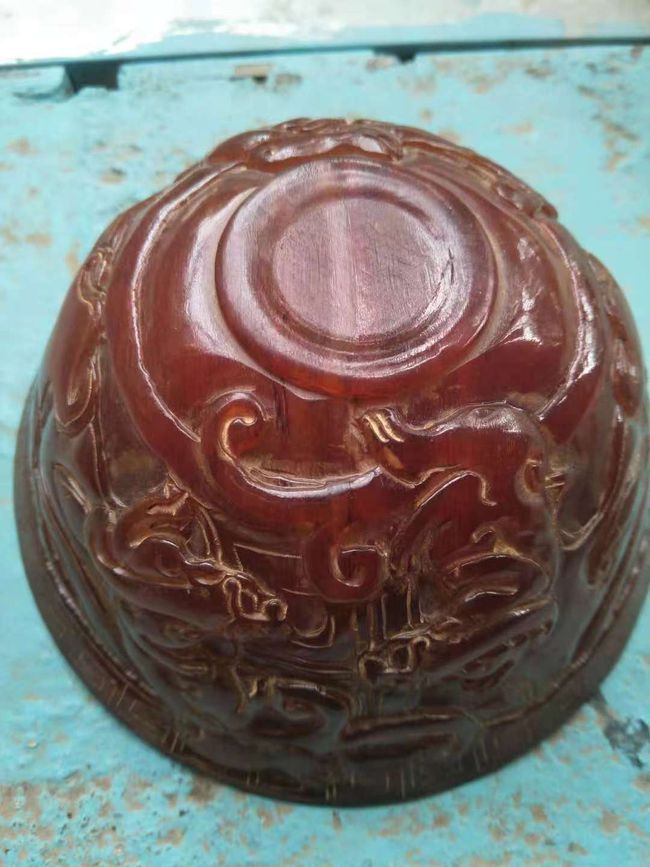藏品名称:犀牛角摆件螭龙碗
规格:直径 112.4mm,高50.8mm
类别:杂项
库存:1
底价:私聊
世界上一共有5种犀牛,即白犀牛、黑犀牛、印度犀牛、爪哇犀牛和苏门答腊犀牛。其中,白犀牛和黑犀牛生活在非洲,而印度犀牛、爪哇犀牛和苏门答腊犀牛则属于亚洲犀牛,通常生活在巴基斯坦北部、印度的阿萨姆邦、尼泊尔、不丹和孟加拉国。印度犀牛则只生活在印度北部的阿萨姆邦和邻国尼泊尔的一些地区。印度犀又称大独角犀,只有一个鼻角,身上的皮肤似甲胄,体型较大,是仅次于白犀的大型犀牛,虽然数量不多,仅千余头,但仍是目前亚洲数量最多的犀牛;爪哇犀又称小独角犀,外形和印度犀很接近,但是体型略小,仅雄性有角。爪哇犀原分布于东南亚广大地区,现在仅存于爪哇岛极西部和越南一处森林中,总数不过几十头,且无人工饲养,是现存最珍贵的动物之一。传说,这种独角犀牛在中国云南西双版纳也有过出现,时间距今20年前。在历史上遍及中国中南部,中国古书中的“兕”就是指这种爪哇犀,中国道教中主神太上老君(老子)的坐骑“青兕”就是以它为原形;苏门犀是现存体型最小和唯一披毛的犀牛,和爪哇犀一样原分布于东南亚的广大地区,现在分布较零星,但尚比爪哇犀分布广泛,数量也略多,现存数百头。
亚洲犀牛和非洲犀牛很容易就能区分出来。鉴别方法之一就是看犀牛角,亚洲犀牛头部长有一只角,而非洲犀牛则长有两只角。另外,还可以从犀牛的皮肤上进行区别,亚洲犀牛的皮肤上清晰可见深深的折痕,就好像穿了铠甲一样,而非洲犀牛的皮肤则比较光滑,没有折痕。
所有的犀牛都是食草动物,通常以青草、水果、树叶和农作物为食,犀牛为了避免一天中气温较高的时段,通常会在早晨或是傍晚出来活动。它们的体重通常可以达到大约2000千克,寿命约为40年左右。
清朝时,人们就对犀牛角种类进行了规范。把产于亚洲及太平洋中部等岛屿上的犀牛角称做为“亚角”;把来自遥远非洲大陆的犀牛角称为“非角”,而“非角”又因其进入中国时的靠岸码头在广州,也有人称之为“广角”。“广角”又名“天马角”,其的纹路较“亚角”细,但药效不及“亚角”。
犀牛角长在犀牛鼻子上,有单角和双角,形状接近圆柱形或大椭圆柱形;一般的牛角长在脑门向两侧分叉,呈扁柱形。犀牛角生长特征具有“前沟后岗”的特点。什么是“前沟后岗”呢?往角尖方向看去,有一条凹下去的沟,是“前沟”,往鼻子方向看去,有一条凸出来的岗,是“后岗”,因为有了这道“岗”,犀牛角杯形器物的边口,有扁形的感觉。
犀牛角有着所有的牛角的共性,就是“前实后空”,“前实”就是指向角尖去的地方是实心的;“后空”就是指向鼻子或脑门去的地方是空心的。牛龄越大,空心则越长,实心则越短。
不管“亚犀”还是“非犀”,都是“珍稀”,而明清犀牛角雕工艺品,更是稀中之稀。
汉武帝时有人进言,说螭龙是水精,可以防火,建议置于房顶上以避火灾;二说是龙九子中的二子,古书中云:“其二曰螭吻,性好望,今屋上兽头是也。”(形体似兽,习性好张望或好险,成为今日庙宇殿顶、堂塔楼阁等高处的龙或屋上的兽顶、殿角的走兽,也可压火灾。)根据以上的说法,螭龙的原形应该是我们生活中的壁虎。
此螭龙犀角碗,整块琢雕,色呈琥珀,泛黄褐,上浅下深,微透光,采用深浮雕,间以透雕技法镌制而成。以一只硕大的犀角掏挖雕就,敞口,两侧雕塑数条螭龙纹,攀爬于杯身两侧,身躯健壮,面目凶悍狰狞,指爪犀利,尾羽飘逸,将螭龙的矫健和苍穹表现的淋漓尽致,杯身通体仿效战汉青铜纹饰,以剔地浅浮雕的手法雕刻,图案纹饰以抽象的兽面纹,又极具抽象效果,雕刻精湛。
There are five kinds of rhinos in the world: white rhino, black rhino, Indian rhino, Javan rhino and Sumatran rhino. White rhinos and black rhinos live in Africa, while Indian, Javan and Sumatran rhinos belong to Asian rhinos. They usually live in northern Pakistan, Assam, Nepal, Bhutan and Bangladesh. India rhinoceros live only in Assam, northern India, and parts of Nepal. Indian rhino, also known as the Big Unihorn Rhino, has only one nose horn, skin like armour, and a larger body. It is the second largest rhino after the White Rhino. Although the number is not large, only more than a thousand, it is still the largest rhino in Asia. Javan rhino, also known as the Small Unihorn Rhino, is similar in shape to Indian rhino rhino, but has a slightly smaller body, only male. Sex has a corner. Javan rhinoceros, originally distributed in the vast areas of Southeast Asia, is now only found in a forest in the Western extreme of Java Island and Vietnam, with a total of only a few dozen, and no artificial breeding. It is one of the most precious animals in existence. Legend has it that this Unicorn rhinoceros has also appeared in Xishuangbanna, Yunnan, China, dating back 20 years ago. Historically, throughout central and southern China, "Yan" in ancient Chinese books refers to this kind of Javan rhinoceros. In Chinese Taoism, the riding of Lao Tzu (Lao Tzu), the goddess of Taoism, is based on it; Sumen rhinoceros is the smallest and only hairy rhinoceros in existence, which is distributed in the vast area of Southeast Asia as Javan rhinoceros. The distribution is fragmentary, but it is more widely distributed than Java rhinoceros.
Asian rhinoceros and African rhinoceros can be easily distinguished. One way to identify rhino horns is to look at them. Asian rhinos have one horn on their head, while African rhinos have two horns. In addition, it can also be distinguished from rhino skin, Asian rhino skin can clearly see deep creases, as if wearing armor, while African rhino skin is relatively smooth, no creases.
All rhinoceroses are herbivores. They usually feed on grass, fruit, leaves and crops. Rhinoceroses usually come out in the morning or in the evening to avoid higher temperatures during the day. They usually weigh about 2000 kilograms and live for about 40 years.
During the Qing Dynasty, the rhinoceros horn species were standardized. The rhinoceros horns from islands such as central Asia and the Pacific are called "sub-horns". The rhinoceros horns from distant African continent are called "non-horns". The "non-horns" are also called "wide-angle" because of their docks in Guangzhou when they enter China. "Wide angle", also known as "Tianma Jiao", has a fine texture than "sub angle", but its efficacy is not as good as "inferior angle".
Rhinoceros horns are long on the nose, with single and double horns, nearly cylindrical or large elliptic cylindrical shape; generally, horns are bifurcated on both sides of the forehead and are flat cylindrical. The growth characteristics of rhino horn are characterized by "anterior furrow post". What is "post ditch"? Looking toward the corner tip, there is a concave ditch, which is the "front ditch". Looking toward the nose, there is a protruding hill, which is the "back hill". Because of this "hill", the edge of rhino horn cup has a flat feeling.
Rhinoceros horn has all the commonalities of horns, that is, "front solid and back empty", "front solid" means that the place pointing to the tip of the horn is solid; and "back empty" means that the place pointing to the nose or the head is hollow. The bigger the ox age, the longer the hollow, the shorter the solid.
Whether "sub-rhino" or "non-rhino", they are "rare", and rhino horn carving crafts in Ming and Qing Dynasties are even rarer.
When Emperor Wudi of the Han Dynasty, someone said that Chilong was water essence and could be fireproof. He suggested putting it on the roof to avoid fire. Secondly, the second son of the Nine Dragons was said in the ancient book: "The second one is kissing and having good sexual expectations, and now the animal head on the house is the same." (Beast-like shape, good habit of looking or dangerous, become today's temple roof, pagodas and other high dragons or roof animal roof, corner beasts, can also press fire.) According to the above statement, the dragon's original shape should be house lizard in our life.
This Chilong rhinoceros horn bowl is carved in whole piece. Its color is amber, yellowish brown, upper shallow, lower deep and slightly translucent. It is made of deep relief and carved with translucent technique. With a huge rhinoceros horn digging and carving, open, two sides of the sculpture of several dragon patterns, climbing on both sides of the cup body, strong body, ferocious face, sharp fingers and claws, tail feathers elegant, the vigor of the dragon and the performance of the sky incisive and vivid, the cup body imitates the Warring Han bronze decoration, to pick out the ground shallow relief sculpture. The decorative pattern of the case is abstracted, and it is very abstract and exquisite.

